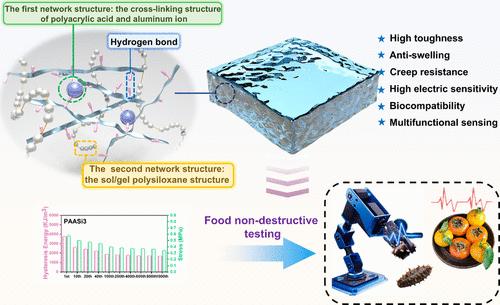Anticreep and Antiswelling Sensor Hydrogel Inspired by Human Pressure Tactile for Food Detection
IF 7
2区 材料科学
Q2 CHEMISTRY, PHYSICAL
引用次数: 0
Abstract
Achieving biomimetic human pressure tactile perception for food detection has been a primary objective in the development of sensing hydrogels. However, the inherent challenges associated with the creeping and swelling behaviors of hydrogels have significantly impeded progress. In this study, we introduce a hydrogel system engineered with a multiscale energy dissipation structure to enable flexible sensing and detection that emulates human pressure tactile. At the molecular scale, the supramolecular interactions, including hydrogen bonding and ionic interactions among macromolecular segments, are incorporated into the hydrogel matrix. At the nanoscale, an elastic spherical mesh structure is integrated to reinforce the hydrogel network. When subjected to external forces, the hydrogel effectively resists creep by absorbing external forces and storing energy. The PAASi hydrogels exhibit remarkable creep resistance (withstanding 1000 compression cycles without deformation), swelling resistance (no volume change after soaking), and high sensitivity (1.16 kPa–1). The sensing systems utilizing PAASi hydrogels have been successfully applied to evaluate the freshness of fruits and the water content in sea cucumbers. This work has guiding significance for irritant response hydrogels in food detection.

受人体压力触觉启发的抗爬行和抗膨胀传感器水凝胶用于食品检测
实现用于食物检测的仿生人体压力触觉感知一直是传感水凝胶发展的主要目标。然而,与水凝胶的蠕动和膨胀行为相关的固有挑战严重阻碍了进展。在这项研究中,我们介绍了一种具有多尺度能量耗散结构的水凝胶系统,以实现模拟人类压力触觉的柔性传感和检测。在分子尺度上,超分子相互作用,包括大分子段之间的氢键和离子相互作用,被纳入到水凝胶基质中。在纳米尺度上,一个弹性的球形网状结构被集成来加强水凝胶网络。当受到外力作用时,水凝胶通过吸收外力和储存能量有效地抵抗蠕变。PAASi水凝胶具有显著的抗蠕变性能(可承受1000次压缩循环而不变形)、抗膨胀性能(浸泡后无体积变化)和高灵敏度(1.16 kPa-1)。利用PAASi水凝胶的传感系统已成功地应用于水果新鲜度和海参含水量的测定。该工作对刺激反应水凝胶在食品检测中的应用具有指导意义。
本文章由计算机程序翻译,如有差异,请以英文原文为准。
求助全文
约1分钟内获得全文
求助全文
来源期刊

Chemistry of Materials
工程技术-材料科学:综合
CiteScore
14.10
自引率
5.80%
发文量
929
审稿时长
1.5 months
期刊介绍:
The journal Chemistry of Materials focuses on publishing original research at the intersection of materials science and chemistry. The studies published in the journal involve chemistry as a prominent component and explore topics such as the design, synthesis, characterization, processing, understanding, and application of functional or potentially functional materials. The journal covers various areas of interest, including inorganic and organic solid-state chemistry, nanomaterials, biomaterials, thin films and polymers, and composite/hybrid materials. The journal particularly seeks papers that highlight the creation or development of innovative materials with novel optical, electrical, magnetic, catalytic, or mechanical properties. It is essential that manuscripts on these topics have a primary focus on the chemistry of materials and represent a significant advancement compared to prior research. Before external reviews are sought, submitted manuscripts undergo a review process by a minimum of two editors to ensure their appropriateness for the journal and the presence of sufficient evidence of a significant advance that will be of broad interest to the materials chemistry community.
 求助内容:
求助内容: 应助结果提醒方式:
应助结果提醒方式:


